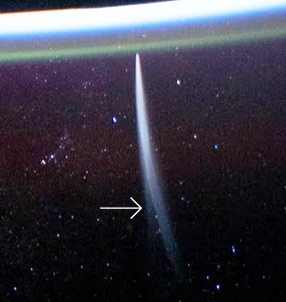I know I post a lot of pictures I describe as amazing, lovely, breath-taking, jaw-dropping… but that’s only because it’s always true. In this case, though, I think those adjectives fall way, way short in describing the seriously paralyzing beauty of this photograph: Comet Lovejoy, as seen by an astronaut on board the International Space Station:
[Click to encomanate – and yes. you need to.]
Oh. My.
This stunning photo was taken by astronaut Dan Burbank as the ISS passed over Australia at 17:40 GMT on December 21, 2011 [update: more pix here]. It was early morning over Australia at the time, and you can see the dark limb of the Earth, the thin green line of airglow (atoms in the upper atmosphere slowly releasing the energy they accumulated over the day), some southern hemisphere stars… and of course, the incredible, ethereal, other-worldly beauty of Comet Lovejoy, its tails sweeping majestically into the sky.
Wait, what? “Tails”, plural? Yup. Hang on a sec. I’ll get to that.
First, the comet was discovered by amateur astronomer Terry Lovejoy in November. It turned out to be a sungrazer, a comet whose orbit plunges it deep into the inner solar system and very close to the Sun’s surface. It screamed past our star last week, on December 15/16, and, amazingly, survived the encounter. Some sungrazers do and some don’t, but Lovejoy is bigger than usual for such a comet, and that may have helped it remain intact as it passed less than 200,000 km over the Sun’s inferno-like surface.
Now the comet is moving back out, away from the Sun and back to the frozen depths of deep space. But the Sun’s heat, even from its greater distance now, is not to be denied. Comets are composed of rock and ice – the ice being what we normally think of as liquid or gas, like ammonia, carbon dioxide, and even good ol’ water. The heat from the Sun turns that ice directly into a gas (in a process called sublimation), which expands around the solid nucleus of the comet, forming what’s called the coma. Pressure from sunlight as well as the solar wind blows this material away from the comet head, resulting in the lovely tail, which can sweep back for millions of kilometers.
 But in many cases, comets have two tails: one made of dust, and another made of gas. The dust tail is made of the fine-grained rock in the comet, let loose as the ices sublimate. This material follows pretty much in the same orbit as the comet itself, so it tends to curve away as seen from Earth.
But in many cases, comets have two tails: one made of dust, and another made of gas. The dust tail is made of the fine-grained rock in the comet, let loose as the ices sublimate. This material follows pretty much in the same orbit as the comet itself, so it tends to curve away as seen from Earth.
The gas, though, gets stripped of electrons by ultraviolet light from the Sun – such a gas is said to be ionized, and is called a plasma. This material is strongly affected by the Sun’s magnetic field and solar wind, which is blowing out from the Sun far faster than the comet itself is moving. Because of this, the ion tail tends to be fairly straight, and point directly away from the Sun. I’ve highlighted Lovejoy’s ion tail in the picture above, stretching the brightness so it’s easier to see.
The ion tail was more obvious just a few days ago, as you can see in this shot taken from the NASA/ESA SOHO solar observatory on December 17 at 06:54 GMT:
The Sun is behind a mask to block its light, and you can see the streamers of the solar wind blowing from it. The comet is on the lower right – the horizontal line going through it is not real, but due to the comet’s brightness flooding the digital detector in SOHO’s camera –and the two tails are easy to see. Many comets display two tails like this, depending on their composition and the conditions in the solar wind at the time. It looks like Lovejoy’s is fading now, but clearly the dust tail is still spectacular.
Right now, Lovejoy is only really visible from the southern hemisphere. If you live Down Under, then getting up an hour or so before sunrise over the next few days will afford you a fantastic view you don’t get too many times in your life. You should take it.
For more stunning views and descriptions of Lovejoy, see the Universe Today website and The Planetary Society Blog.
Image credit: NASA/Dan Burbank c/o Fragile Oasis; NASA/ESA/SOHO/Helioviewer.org